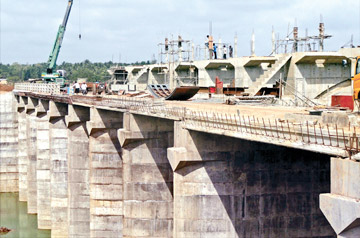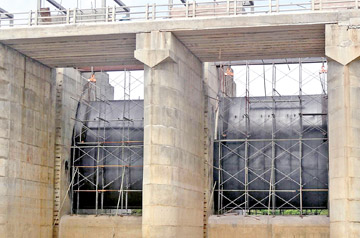Deduru Oya reservoir project, a milestone for NWP farmers
by P. Krishnaswamy
The multi-purpose Deduru Oya Reservoir Project which is due to be
commissioned in November this year will mark an important milestone in
the life of the agricultural communities of the North Western Province (NWP),
who time and again have faced hardships and livelihood problems due to
changing weather patterns and failed seasonal rains.
 |
| The main dam
of the Deduru Oya reservoir |
 |
| Work nears
completion |
 |
| The radial
gates of the spillway |
The impounding of the reservoir of 75 MCM capacity will be completed
in October this year with the process already been started, followed by
the release water to the Right Bank and Left Bank canals immediately
thereafter, Project Director Engineer B.A.S. Sunil Perera told the
Sunday Observer.
Paddy lands in the Deduru Oya and the Mee Oya basins will come under
cultivation in both seasons benefiting over 15,000 agricultural families
while about 50,000 families will benefit from domestic water facilities,
lift irrigation and extension of inland fisheries culture, Perera said.
The project is one more achievement under the ‘Mahinda Chintana’
concept on food security in the country. There has been a marked
progress in the production of rice and other crops under the Mahaveli
Development programs and other multi-purpose irrigation and water supply
projects implemented under the concept.
Dry zone
The main problem hitherto faced by farmers in the Deduru Oya and Mee
Oya basins is the non-availability of assured water supply for the
agricultural areas since the basins are predominantly situated in the
dry zone of the country. The water available with the rainfall and
collected in the existing irrigation schemes is not sufficient for
two-season cultivation.
Seventy percent of annual rainfall in the Deduru Oya catchment flows
to the ocean without being used in any way to serve the needs of the
local population. As a result an optimal level of agricultural
development has not been achieved. The Deduru Oya Reservoir project, on
completion, will resolve all these problems while bringing many more
benefits, the Project Director said.
All major components of the projects, including the main bund, the LB
sluice, the RB sluice, electro mechanical and civil works (concreting)
of the spillway, the causeway and the Magalla RB extention (11 km) have
been completed 100 percent while only little work remains to be
completed on the RB transbasin canal (33 km) and LB transbasin canal (
44 km), he said.
Issuing water to the Inginimitiya reservoir which part of the project
will be in January 2015. On release of water to the Inginimitiya
reservoir in the Anamaduwa area, the local agricultural communities will
derive the same benefits, Perera said.
Private and state lands were acquired for the project, needing
payment of huge amounts as compensation.
Over 6,200 private and state lands had to be acquired in the
Divisional Secretariat areas of Maho, Maspotha, Ganewatte and Wariyapola
and compensation has already been paid to 97.7 percent of the owners.
The amount paid as compensation up to end of April 2014 is Rs.1602.4 Mn
and the process of paying the remaining compensation amounts is in
progress, the Project Director said.
Sixth largest river
Of the 600 families needing resettlement assistance, 582 families
which represent 97 percent have already been resettled in Karuwalagwewa
-Radawihediella, Kobeyigane-Thelhera Farm, Polmmana and
Ganewatte-Petarweliya phased over a period of seven years from 2007 to
2013, Perera said.
Other salient features of the project as provided by the Project
Director are:
The project site is located within the Maho, Wariyapola and
Ganewaththa Divisional Secretariat areas in the Kurunegala district.
Construction of the concrete spill structure and the hydro power station
of 1.5 MW has been completed.
Deduru Oya is the sixth largest river in Sri Lanka which is about 142
km in length and has a water resource area of about 2,420 sq. km.
The objective of the project is to prevent about 1,000 billion sq.
metres of water flowing out to the sea without being used for productive
purposes.
History bears witness to the fact that during the reign of King
Parakramabahu the Great, dams were built at three locations basing the
Deduru Oya and the water was used for irrigation purposes. The Ministry
of Power and Energy is in charge of the 1.5 megawatt power plant. The
National Water Supply and Drainage Board has constructed the water
treatment plant to provide drinking water to over 50,000 families. The
canal which feeds the Inginimitiya reservoir is concrete-lined and its
discharge capacity is 300 cubic feet per second.
Infrastructure facilities to the people of the Maho, Wariyapola
Karuwalagaswewa and Ganewaththa Divisional Secretary divisions include
road networks, electricity, schools and clean drinking water which will
immensely contribute to the improvement of their quality of life.
Unique achievement
Everything, beginning from conducting the feasibility study to
designing the various components of the reservoir construction, was done
by engineers of the Irrigation Department and this is considered to be a
unique achievement of the Sri Lankan engineers.
The project will invariably contribute to consolidating the national
plan of food security in the country. It will attract a tourist flow to
the project site and the surrounding settlement areas. Productivity of
not only paddy but also other highland crops, including vegetables and
fruits, will increase many fold contributing further to the
socio-economic betterment of the agricultural families. The necessity of
development programs for the benefit of the population of the dry zone
and intermediary zones in Sri Lanka arose due to many reasons but mainly
owing to the food security of the people. The lack of food security
arose due to disruption of agrarian systems, land fragmentation, lack of
irrigable land, indebtedness of the farmers and poor post-harvest
technology. The backbone of the population of the dry zone and the
intermediary zones of Sri Lanka is based on agriculture with almost 85
percent of them depending on it for their livelihood. Nearly two-thirds
of the land area of the country comes under the dry zone, an area with
low annual rainfall and pronounced dry season. The dry zone is mainly
rural, with many households relying on agriculture for their livelihood.
However the contribution that agriculture makes to household income
has been declining and poverty and unemployment have been on the rise.
The development and improvement of the water resources in the dry zone
is necessary to obtain the efficient and maximum use of the vastly
available land resources of the area. Therefore, water storage and
proper management for successful irrigated cropping is a prime
requirement for agriculture development.
The projects had also contributed to rural development, health care
services and socio-economic uplift of the local communities. The Deduru
Oya multipurpose reservoir project is one more jewel in the chain of
many such mega multi-purpose reservoir projects implemented under the
‘Mahinda Chintana'. Many more similar projects are under implementation
in the country to ensure efficient and maximum use of the vastly
available land resources and the improvement of the standard of live of
the people.
By 2020, the irrigation sector will become a key driving force in
agricultural development with the supply of water in adequate, equitable
and reliable quantities and in a sustainable, efficient and eco-friendly
manner. |

